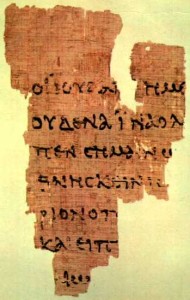Curious…
Feed: Fundamentally Reformed
Posted on: Wednesday, February 08, 2012 5:31 AM
Author: Bob Hayton
Subject: Earliest NT Manuscript Discovered???
Dr. Daniel Wallace spilled the beans in a recent debate with Bart Ehrman that there has now been discovered a papyrus fragment of Mark that has been dated to the 1st Century. This would make the manuscript earlier than P52, a manuscript fragment of the Gospel of John dated to A.D. 125. The publication of the new manuscript fragment, and any additional details about its discovery, will not be available until next year, unfortunately. There are indications, however, that the fragment appears to be part of the Green collection, which claims to include "one of the world's largest holdings of unpublished biblical and classical papyri." More details on that collection, here. At Sheffield Biblical Studies blog, I found the following tidbit with more details about the new discoveries.
As for where these manuscripts have been found, there is no official word, but the following tidbit about the director of the Green collection may have the answer:
I was able to learn that the technical term for this is cartonnage (papyrii and other linens and fabric that was molded into funeral masks for Egyptian mummies). So the assumption is that most of these fragments may have been found through Carroll's innovative method of extracting papyrii from cartonnage. And as Matthew Hamilton mentioned over in the comments at Evangelical Textual Criticism blog, this could have important ramifications for the ability to date the papyrii with precision.
We will have to wait for more information on this, but even if these fragments are quite small, they still (if the early dates hold) stand as added testimony to the authenticity of the New Testament. I should note in passing, that with the size of the fragment, it is almost surely not going to contain profound new insight of lasting text-critical value. The dream-scenario that Paul Maier writes about in The Constantine Codex of a textual discovery that forever settles the question of Mark's ending, remains fiction, for now. |
 Over on my team blog,
Over on my team blog,
No comments:
Post a Comment
Note: Only a member of this blog may post a comment.